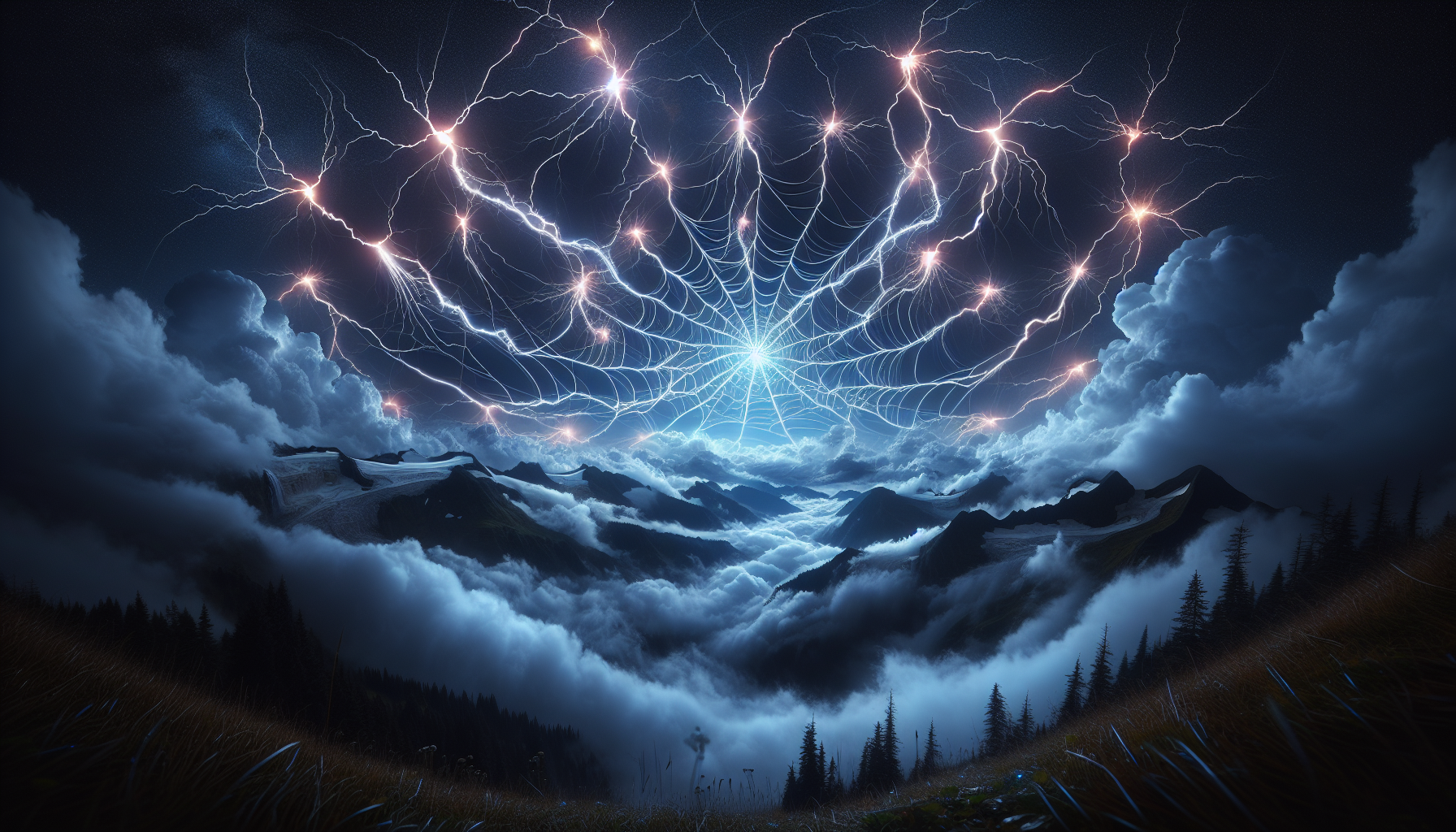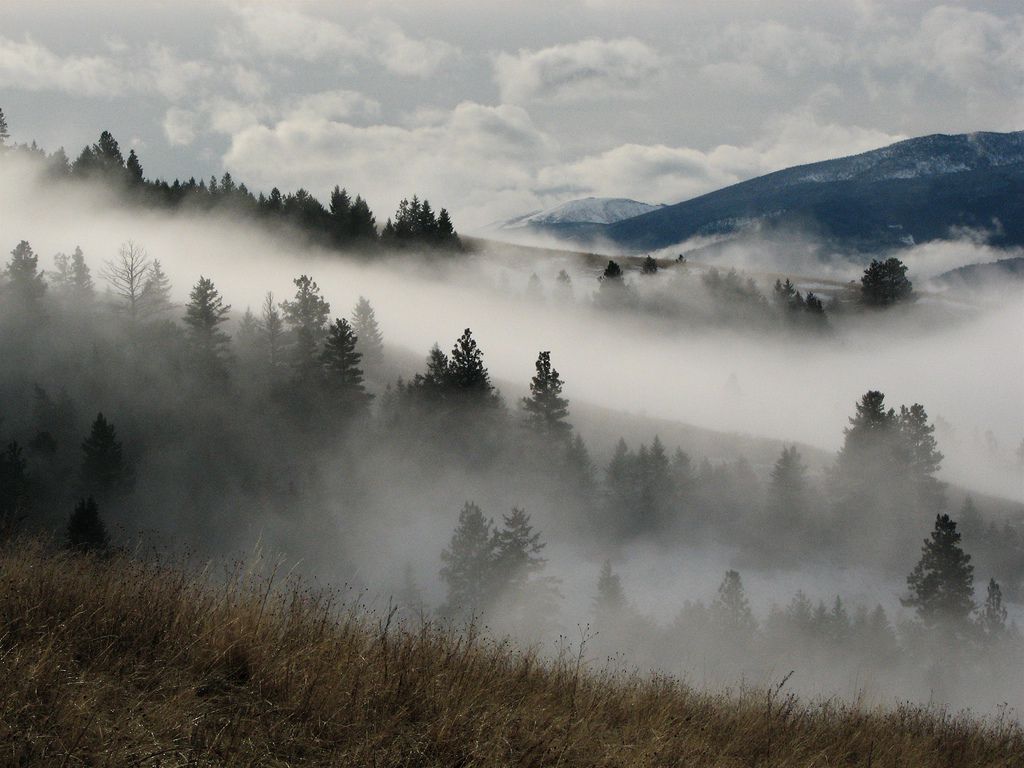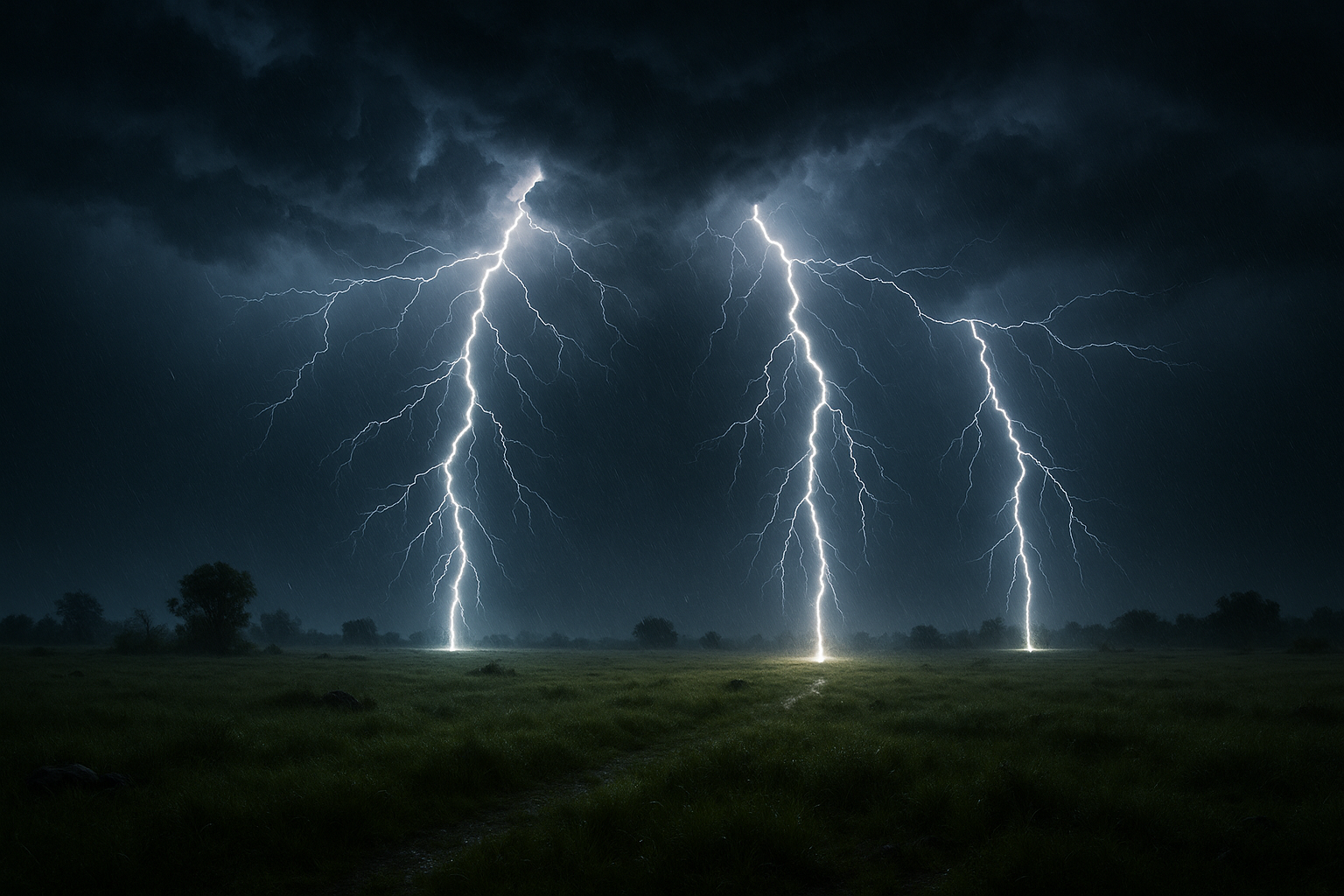In the grand tapestry of the natural world, there are few phenomena as mesmerizing and awe-inspiring as the dance of lightning across the sky. A fleeting yet profound spectacle, lightning is a testament to the raw power and intricate beauty of Mother Nature. Among the various forms of lightning, there’s one that captures our imagination like no other—spider lightning. This rare and captivating phenomenon, with its sprawling, web-like tendrils stretching across the heavens, is a true marvel to behold. In this article, we invite you on an exhilarating journey to explore the wonders of spider lightning, unraveling its mysteries and celebrating its spectacular display.
Imagine standing on an open plain as the sky darkens, the air charged with anticipation. Suddenly, a flash illuminates the night, revealing a network of radiant veins spanning the sky—this is spider lightning. Unlike the typical lightning bolt that strikes in a direct line, spider lightning crawls horizontally, creating a breathtaking web of light. But what causes this extraordinary display? How does it differ from other types of lightning, and what makes it so special? We will delve into the science behind spider lightning, shedding light on its formation, characteristics, and the unique conditions required for its occurrence. ⚡️
Yet, understanding the science is just the beginning. Spider lightning is not merely a scientific curiosity; it is a source of inspiration and wonder for artists, photographers, and dreamers alike. The visual spectacle it creates has a profound impact on those fortunate enough to witness it, evoking emotions ranging from awe to tranquility. We will explore the cultural and artistic significance of spider lightning, examining how it has been captured in art, literature, and folklore throughout history. From ancient myths to modern photography, spider lightning continues to ignite the human imagination, serving as a symbol of nature’s untamed beauty and power.
Of course, capturing the perfect shot of spider lightning is no small feat. For photographers, this electrifying pursuit requires patience, skill, and a dash of luck. In our journey, we will provide practical insights and tips for capturing stunning images of spider lightning, whether you are a seasoned photographer or a curious amateur. From choosing the right equipment to understanding weather patterns, we’ll guide you through the process of immortalizing these fleeting moments, allowing you to share the magic of spider lightning with the world.
Finally, as we explore the wonders of spider lightning, we will also reflect on our relationship with the natural world. In an era where technology often distances us from nature, phenomena like spider lightning remind us of the earth’s intrinsic beauty and power. They inspire us to reconnect with the environment, fostering a sense of stewardship and appreciation. By the end of this article, we hope you will not only understand spider lightning more deeply but also carry a renewed sense of wonder and respect for the incredible dance of electricity that unfolds in the skies above. Join us as we unleash the power of nature and witness the spectacular beauty of Mother Nature’s electric dance. 🌿
Understanding Spider Lightning: A Phenomenon Like No Other
Spider lightning, also known as anvil crawlers, is a mesmerizing atmospheric phenomenon that captivates those fortunate enough to witness its grandeur. Unlike the typical forked lightning bolts that strike directly from clouds to the ground, spider lightning stretches horizontally across the sky. This expansive display resembles the legs of a spider sprawled across the clouds, hence its name. This unique characteristic makes spider lightning one of the most visually stunning forms of lightning, often spanning several miles. The phenomenon primarily occurs within the anvil cloud portion of a thunderstorm, where the electrical potential difference facilitates this sprawling light show.
The formation of spider lightning is intrinsically linked to the structure of the thunderstorm and the charge distribution within it. As the storm matures, positive and negative charges accumulate in different parts of the cloud, creating a highly electrified environment. In the anvil, or the upper portion of the cloud, there is often a significant difference in electric charge compared to the surrounding atmosphere. When this difference becomes large enough, the energy discharges horizontally, creating the striking visual effect of spider lightning. The vastness of these displays is not only a testament to the power of nature but also a reminder of the intricate balance within atmospheric dynamics.
Spider lightning is predominantly observed during mature thunderstorms, especially those with well-developed anvil clouds. It is more common in certain geographic locations, particularly in areas prone to severe thunderstorms, such as the central United States during spring and summer months. This phenomenon is not only a spectacle for storm chasers and weather enthusiasts but also an important area of study for meteorologists seeking to understand the complexities of storm dynamics and electrical activity in the atmosphere. To fully appreciate the beauty and power of spider lightning, one must delve into the atmospheric conditions that give rise to this breathtaking spectacle.
The Science Behind Spider Lightning
The scientific exploration of spider lightning involves understanding the electrical processes within thunderstorms. Thunderstorms are complex systems driven by a multitude of factors, including temperature, humidity, and atmospheric pressure. The development of spider lightning within these storms is closely associated with the buildup and discharge of electrical charges. In the upper portions of a thunderstorm, known as the anvil, charged particles accumulate due to the movement of ice crystals and water droplets. This charge separation creates an electric field, and when the potential difference between charged areas becomes sufficiently large, lightning occurs.
The horizontal nature of spider lightning is a result of the charge distribution within the anvil cloud. Unlike typical cloud-to-ground lightning that travels vertically, spider lightning spreads across the sky. This horizontal spread can extend for miles, illuminating the night with intricate patterns of light. The branching paths of spider lightning are influenced by the presence of charged particles and the structure of the cloud itself. This complex interaction between the charged particles and the atmospheric environment is what makes spider lightning a subject of fascination for both scientists and spectators alike.
Research into spider lightning continues to uncover new insights into the behavior of electrical discharges within storms. Advances in technology, such as high-speed cameras and lightning detection networks, have allowed scientists to capture and analyze these phenomena in unprecedented detail. By studying spider lightning, researchers aim to improve our understanding of lightning formation, predictability, and the potential impacts on the environment. The knowledge gained from these studies not only enhances our comprehension of natural phenomena but also informs safety measures and risk assessments for communities affected by severe weather. To see the spectacular beauty of spider lightning in action, watch this captivating video on YouTube.
The Impact of Spider Lightning on the Environment and Technology
While spider lightning is primarily an awe-inspiring natural event, it also has implications for both the environment and human technology. The electrical discharges associated with spider lightning can affect various components of the ecosystem. Lightning strikes can ignite wildfires, particularly in dry, forested areas, leading to widespread ecological and economic consequences. The heat generated by lightning can also impact soil composition and plant life, creating both challenges and opportunities for the natural world. Understanding these effects is crucial for managing and mitigating the risks associated with lightning activity.
In addition to its environmental impact, spider lightning poses challenges to technology and infrastructure. The expansive reach of spider lightning means that electrical discharges can affect a wide area, potentially damaging power lines, telecommunications networks, and other critical systems. Engineers and designers must consider these factors when developing technology to withstand the forces of nature. Advances in lightning protection and detection technologies aim to minimize the risk and damage caused by electrical storms, ensuring the resilience of vital infrastructure.
Despite the challenges posed by spider lightning, it also presents opportunities for scientific advancement and innovation. The study of lightning and electrical phenomena has led to developments in fields ranging from meteorology to electrical engineering. By harnessing the power of lightning, researchers continue to explore new ways to generate and store energy, providing potential solutions for sustainable power generation. As our understanding of spider lightning grows, so too does our ability to harness the power of nature for the benefit of society.
| Sector | Impact of Spider Lightning |
|---|---|
| Environment | Can ignite wildfires, affect soil composition, and impact plant life. |
| Technology | Potential to damage infrastructure such as power lines and communication networks. |
| Research | Opportunities for advancements in meteorology and electrical engineering. |
Witnessing Spider Lightning: Where and How to Experience It
For those captivated by the beauty of spider lightning, experiencing this phenomenon in person is a thrilling opportunity. Spider lightning is most commonly observed in regions prone to severe thunderstorms, particularly in the central United States. States like Oklahoma, Kansas, and Texas are known for their active storm seasons and provide ideal locations for witnessing this electrifying display. Timing is crucial, as spider lightning is more prevalent during the late spring and summer months when thunderstorms are most active.
Safety is paramount when seeking to observe spider lightning. Storm chasing, while exciting, requires careful planning and an understanding of the risks involved. Observers should always monitor weather forecasts and heed warnings from meteorological services. Staying informed about storm developments and maintaining a safe distance from severe weather is essential to ensure a safe and enjoyable experience. For those unable to travel to storm-prone areas, online platforms and social media provide access to stunning images and videos of spider lightning captured by storm chasers and photographers.
- Spider lightning primarily occurs within anvil clouds.
- The phenomenon is a result of charge distribution within storms.
- Safety and planning are crucial for storm chasing enthusiasts.

Conclusion
In conclusion, the exploration of “Unleash the Power of Nature with Spider Lightning Captures: Witness the Spectacular Beauty of Mother Nature’s Electric Dance” has been an illuminating journey into the mesmerizing phenomena that take place in the natural world. Throughout this article, we’ve delved into the intricate details of spider lightning, understanding its formation, the scientific principles behind its dazzling displays, and the awe it inspires in those fortunate enough to witness it.
We’ve learned that spider lightning, with its sprawling, web-like flashes across the sky, is not just a testament to nature’s power but also a reminder of the beauty and complexity inherent in our environment. This form of lightning, often occurring during thunderstorms, is characterized by its horizontal propagation and can cover vast distances, painting the sky with electrifying artistry. Scientists and enthusiasts alike are drawn to these stunning displays, eager to capture their magnificence through photography and study.
The significance of understanding spider lightning goes beyond mere appreciation. It represents an intersection of science, art, and technology, where each field contributes to a greater comprehension of atmospheric phenomena. Meteorologists study these patterns to improve weather prediction models, while photographers capture these fleeting moments, offering us a glimpse into the dance of electrons that occurs miles above our heads. By understanding these natural events, we not only enrich our knowledge of the world but also contribute to advancements in safety and predictive measures, potentially mitigating the risks associated with severe weather conditions.
The article emphasized the role of technology in capturing the essence of spider lightning. High-speed cameras and advanced imaging techniques have revolutionized our ability to document these occurrences, allowing us to freeze moments in time and examine them in detail. This technological advancement has opened new doors for both scientific research and artistic expression, enabling us to share the splendor of these natural wonders with a global audience.
Furthermore, the article touched upon the cultural and emotional impact of witnessing such natural spectacles. Spider lightning serves as a powerful metaphor for the unpredictable and interconnected nature of our lives. Its sudden appearance and ephemeral beauty remind us of the transient moments that shape our experiences, encouraging us to pause and appreciate the wonders around us. This natural phenomenon becomes a source of inspiration, fueling creativity and a sense of awe that transcends cultural and geographical boundaries.
The importance of this topic extends to its environmental implications. As we deepen our understanding of lightning and its various forms, we become more attuned to the broader changes occurring in our climate. Monitoring lightning patterns contributes to climate studies, helping scientists track shifts in weather systems and providing crucial data for addressing climate change challenges. By highlighting spider lightning, we underscore the need for continued research and conservation efforts to preserve the delicate balance of our planet’s ecosystems.
Inspiring a sense of curiosity and wonder, the article invites readers to engage with the natural world in new ways. Whether you’re a scientist, photographer, or simply a nature enthusiast, there’s a call to action to explore further, to document and share your experiences, and to join a community that celebrates the marvels of our planet. The beauty of spider lightning is not just in its visual impact but also in its ability to connect us to something greater than ourselves—a reminder of the planet’s dynamic and ever-evolving nature.
To further explore the phenomenon of spider lightning and related atmospheric studies, consider visiting reputable sources such as the National Oceanic and Atmospheric Administration (NOAA) NOAA’s Lightning Information and the American Meteorological Society . These resources offer a wealth of information on weather patterns, lightning research, and climate studies, providing valuable insights into the complexities of our atmosphere.
As we conclude this exploration of spider lightning, I encourage you to reflect on the insights gained and consider how you might incorporate this newfound knowledge into your life or work. Whether through photography, scientific inquiry, or simply sharing the awe of these natural wonders with others, there are countless ways to engage with and appreciate the power of nature. Let us celebrate the electric dance of Mother Nature, recognizing its beauty and significance as we continue to explore and learn from the world around us. 🌩️✨
Please share your thoughts or experiences with spider lightning in the comments below. Your stories and insights can inspire others to look up and witness the breathtaking spectacles that nature has to offer. Don’t forget to share this article with friends and family, inviting them to join in the marvel of our planet’s electrifying performances. Together, let’s keep the conversation alive and nurture our collective appreciation for the wonders of the natural world.
Toni Santos is a visual storyteller and artisan whose creations celebrate the poetry of the natural world. Through his thoughtful artistic lens, Toni captures the elegance of botanical forms, transforming them into meaningful expressions of symbolism, resilience, and timeless beauty.
His journey is deeply rooted in a passion for flora and the mysteries they carry. From the shape of a petal to the curve of a vine, each design Toni brings to life reflects a deeper narrative — one of growth, transformation, and harmony with nature. Whether crafting symbolic floral jewelry, enchanted botanical illustrations, or seasonal visual studies, Toni’s work evokes the quiet magic found in Earth’s most delicate details.
With a background in handcrafted artistry and visual design, Toni blends technique with intention. His creations do more than decorate — they speak, often inspired by ancient meanings behind flowers, the cycles of the seasons, and the invisible bonds between nature and spirit.
As the creative voice behind Vizovex, Toni shares this botanical journey with the world, offering curated stories, handcrafted collections, and thoughtful articles that help others reconnect with nature’s symbolism and artistic essence.
His work is a tribute to:
The quiet power of flowers and their messages
The art of visual symbolism in everyday life
The beauty of slowing down to see what’s hidden in plain sight
Whether you’re an artist, a nature lover, or someone drawn to the deeper meanings behind the natural world, Toni welcomes you to explore a space where aesthetics meet soul — one petal, one story, one creation at a time.





